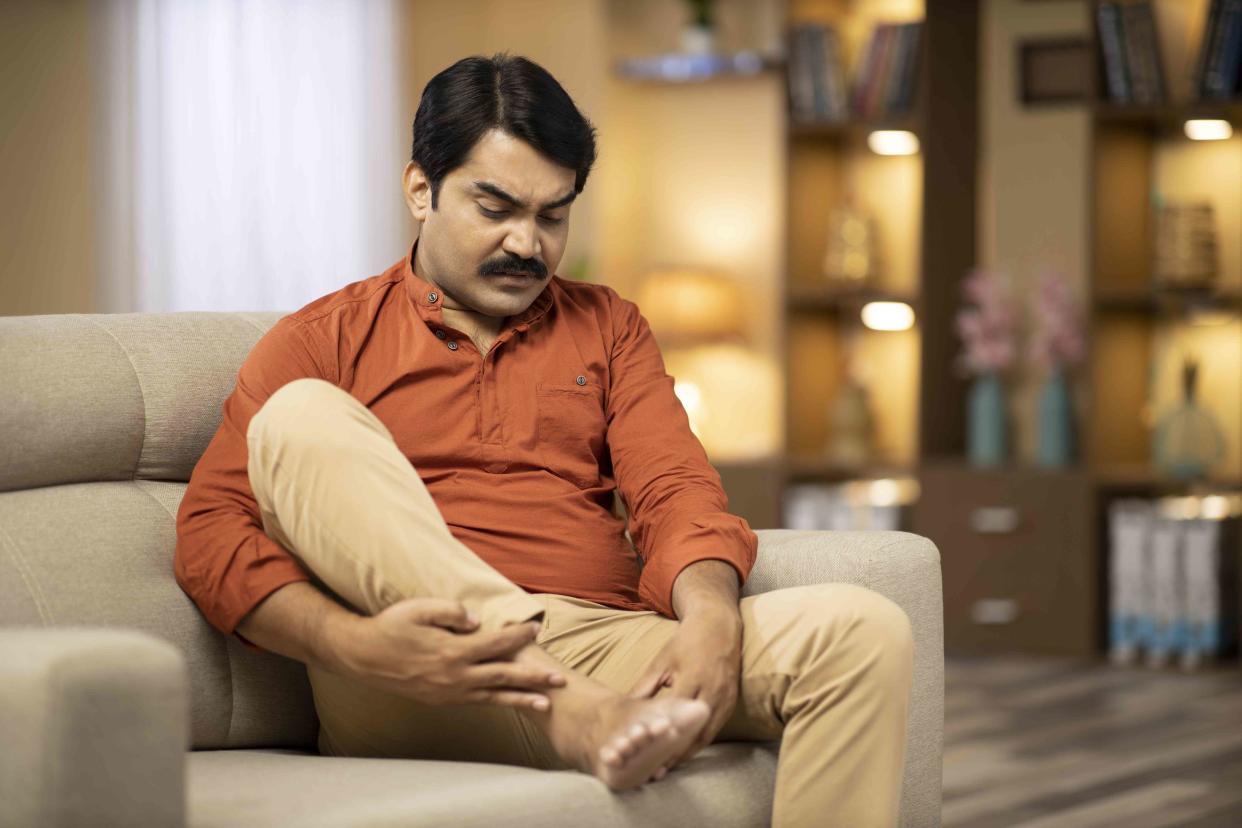Signs and Symptoms of Plantar Fasciitis

Deepak Sethi / Getty Images
Medically reviewed by Danielle McNeil, D.P.M
Plantar fasciitis is a common foot condition that develops when the plantar fascia becomes inflamed and irritated, often due to repetitive stress or strain on the foot. The plantar fascia is a thick band of tissue that runs along the bottom of the foot and connects the heel bone to the toes. Sharp, stabbing heel pain is the hallmark symptom of plantar fasciitis. In some cases, the pain may radiate along the arch or sole of your foot.
Generally, plantar fasciitis symptoms usually start mildly and gradually worsen over time. Symptoms can also look different from person to person. While some people may experience periodic, temporary flares of intense heel pain, others may have persistent, chronic discomfort in their feet.
Heel Pain
The primary symptom of plantar fasciitis is heel pain, which may feel like a sharp or stabbing pain, a burning sensation, or a dull ache at the bottom of your heel. You may notice that your pain gets worse when you wake up in the morning and take your first steps or once you get up after sitting or resting for an extended period of time.
Plantar fasciitis-related heel pain usually subsides within 10 minutes of walking or stretching. However, your heel may begin to ache more toward the end of the day after completing a day's worth of activities. This often happens because of the pressure of standing on your feet for long periods of time. Climbing stairs and participating in intense exercise (e.g., jumping or running) can also trigger or worsen plantar fasciitis heel pain.
Swelling
Inflammation of the plantar fascia can lead to swelling and redness around your heel and the arch of your foot. When this happens, your foot may appear to be red or swollen. But, swelling in your foot might not always be visible. In such cases, your heel and the surrounding area of your foot and ankle may feel puffy or tender when touched.
Stiffness
Plantar fasciitis can cause stiffness or tightness in your foot, especially in the morning or after prolonged periods of inactivity. This stiffness is often accompanied by heel pain and tends to improve as you move and stretch your foot throughout the day.
Daily activities can put extra pressure and demands on your feet. For example, walking, running, taking the stairs, or standing too long can all worsen the stiffness. It's common for those with plantar fasciitis to experience stiffness and tightness in their feet by the end of the day.
Foot Arch Pain
Along with heel pain, many people with plantar fasciitis experience pain in the foot's arch or side. The inflammation and strain on the plantar fascia can radiate along the sole of the foot, causing discomfort in the arch area. This pain may feel like a dull ache or tightness and can limit your ability to walk or comfortably engage in activities that place extra weight on your feet.
Achilles Tendon Pain
While plantar fasciitis primarily involves inflammation of the plantar fascia, you may also feel some symptoms in the Achilles tendon—a part of the foot that runs along the back of the lower leg and attaches to the heel bone. The strain in the plantar fascia can change how you move your leg and foot. In some cases, tightness in the plantar fascia can cause your foot to roll inward while walking, which can increase stress and tension on the Achilles tendon, leading to Achilles pain.
When to See a Healthcare Provider
If you think you may be at risk of developing plantar fasciitis or are experiencing heel pain for more than a week, it's good practice to see your healthcare provider. Your primary care provider can assess your symptoms, order tests, or refer you to a podiatrist (a doctor who specializes in problems with the feet and lower legs).
If you develop severe pain, cannot bear weight on the affected foot, or have signs of infection (e.g., redness, warmth, and fever), seek immediate medical attention from a provider to rule out any serious complications.
A Quick Review
Plantar fasciitis is a common foot condition that occurs when your plantar fascia becomes inflamed. This can result in intense heel or arch pain, swelling, and stiffness. Symptoms typically start mildly and gradually worsen over time. Seeking medical attention from a healthcare provider and getting tested for the condition can help relieve symptoms, prevent complications from occurring, and improve your foot health.
Frequently Asked Questions
What worsens plantar fasciitis symptoms?
Plantar fasciitis symptoms can worsen after activities that strain the foot, such as prolonged standing, walking, or running, and using inadequate footwear.
Does plantar fasciitis ever go away?
Plantar fasciitis can heal with proper treatment and management. Complete healing may require time, rest, and lifestyle adjustments. About 90% of people with plantar fasciitis feel better within 10 months of starting treatment.
Does walking help plantar fasciitis?
While walking can help maintain flexibility and strength, it may worsen plantar fasciitis symptoms if you wear unsupportive footwear. Footwear that supports the arch of your foot and provides adequate cushioning for your heel is best when living with plantar fasciitis. Rest and plantar fascia stretches can help manage the condition and reduce pain and inflammation.
For more Health news, make sure to sign up for our newsletter!
Read the original article on Health.

